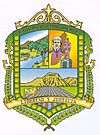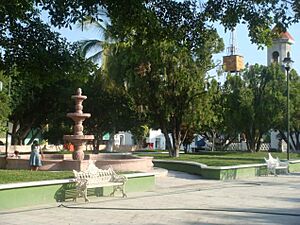Parácuaro facts for kids
Quick facts for kids
Parácuaro
|
||
|---|---|---|
|
||
| Country | Mexico | |
| State | Michoacán | |
| Municipal seat | Parácuaro, Michoacán | |
| Time zone | UTC-6 (CST) | |
| • Summer (DST) | UTC-5 (CDT) | |
| Website | Página web de Parácuaro Michoacan | |
Parácuaro is a town and a municipality in the Mexican state of Michoacán. The name "Parácuaro" comes from the Purépecha language. It means "place that has sticks for a roof."
Contents
History of Parácuaro
Early Inhabitants and Spanish Rule
Long ago, before the Spanish arrived, people called Nahuas lived in Parácuaro. Later, a powerful chief named Tarasco Utucuma took control of the area.
During the time of Spanish rule, Parácuaro became part of the "Republic of the Indias." The Spanish also built large farms called haciendas here. Some of these were named La Guadalupe, El Valle, and La Perla.
Becoming a Municipality
For many years, Parácuaro was part of Apatzingán. But on November 20, 1861, the state government made Parácuaro its own municipality. It was then called Villa de Parácuaro de Morelos.
Population of Parácuaro
About 25,582 people live in Parácuaro.
Geography and Landscape
Location of Parácuaro
Parácuaro is in the southwest part of the state of Michoacán. It sits about 600 meters (nearly 2,000 feet) above sea level. The town is about 200 kilometers (124 miles) from the capital of Michoacán.
It shares borders with other towns. To the north are Tancítaro and New Parangaricutiro. To the east are Gabriel Zamora and Múgica. To the south and west, it borders Apatzingán.
Mountains and Hills
The land in Parácuaro has many interesting features. It is part of a large mountain chain called the volcanic transverse system. There are also several hills, including Aguacate, Jabalí, Cofradía, Güera, Vueltas, Batea, and White.
Rivers and Water Sources
Parácuaro has several rivers that flow through it. These include the Aguacate, Orejón, Lancita, Paracuarito, and Manga rivers. There are also natural springs with cold water, like the Chicos, the Pozos, and Cortijo springs.
Climate and Weather
The climate in Parácuaro is tropical. This means it is warm all year round. Most of the rain falls during the summer months. The area gets about 800 millimeters (31 inches) of rain each year. Temperatures usually range from 14 to 36 degrees Celsius (57 to 97 degrees Fahrenheit).
Plants and Ecosystems
The main type of plant life here is the tropical forest. You can find trees like tepeguaje, guaje, ceiba, parota, zapote, and mango. There are also thorny forests with plants like teteche, viejito, huisache, and amole.
Economy and Local Industries
Farming and Crops
Farming is very important in Parácuaro. Farmers grow many different crops. The main ones include cotton, rice, corn, melon, sorghum, sesame, tomato, cucumber, and watermelon.
Raising Animals
Many people in Parácuaro also raise animals. The most common animals are cattle, horses, and pigs.
Tourism and Resorts
Parácuaro has two resorts. These places offer fun activities and places to stay for visitors.
Local Trade
The town produces enough basic goods for its people. It is also known for selling fruits, groceries, and vegetables.
Services for Visitors
If you visit Parácuaro, you can find places to stay. The municipal office can help you find accommodations, bungalows, and food services.
Famous People from Parácuaro
Parácuaro is the hometown of some well-known people.
- Juan Gabriel (born Alberto Aguilera Valadez) was a very famous singer and songwriter.
- Agustín Bernal (born Romualdo Bucío Bucío) was an actor and director. He made many Mexican films. People compare his influence to that of Arnold Schwarzenegger and Sylvester Stallone in Hollywood.
- Actress Elpidia Carrillo was also born here. She is famous for her role in the movie Predator (1987), where she acted with Arnold Schwarzenegger.
Culture and Attractions
Important Buildings
You can visit Parácuaro's main church, called the parish. There is also a monument dedicated to Cenobio Moreno.
Holidays and Traditions
Parácuaro celebrates many special days throughout the year:
- November 20: People celebrate the start of the Mexican Revolution.
- August 1 to 15: This is a big holiday for the Virgin of the Assumption.
- September 15 and 16: These are national holidays celebrating Mexico's independence.
- Other holidays: The town also celebrates carnival at the beginning of each year and Christmas holidays.
Handmade Crafts
Local artisans create beautiful items. They make furniture from wood and also create items in a harness-maker's shop.
Traditional Foods
When you visit Parácuaro, you can try many delicious local foods:
- morisqueta
- Iguana soup
- Fish soup (made with bagre or carpa)
- Corn tamales with cream (called uchepos)
- Corundas de maíz with cheese and cream
- tacos de res y chivo (beef and goat tacos, like barbacoa)
- enchiladas with chicken and cecina (dried meat)
See also
 In Spanish: Parácuaro (Michoacán) para niños
In Spanish: Parácuaro (Michoacán) para niños



